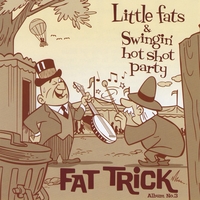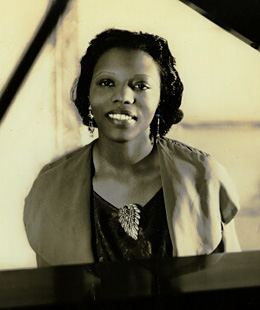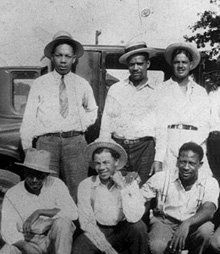
DJ lounge rooms via Germany.
Category Archives: music
firehouse five
 My desire for the Firehouse Five (specifically this album) has forced me to think, even more seriously (as in, will probably do it) about emusic.
My desire for the Firehouse Five (specifically this album) has forced me to think, even more seriously (as in, will probably do it) about emusic.
This band is in the vein of the New Orleans Jazz Vipers, the Firecrackers and other recreationist bands. Excepting the Firehouse Five are actually from the revivalist period (mostly). I’ve just bought this CD, but I think I could go on and on and on. I know it’s tighty-whitey cultural appropriation, but dang. The quality is good. And, well. You know. I want it. And thinking about music means I don’t have to think about the masses of reading I have left to do.
But the sudden plummeting dollar has meant that buying CDs is expensive, mostly because of the postage. I like to have the liner notes, emusic will hit me with an extra bill each month, but… instant music. Sweet. Cheaper music. Double sweet. I think I will use it for ‘taster’ songs, finalising my departure from itunes, and for albums by newer artists where I don’t need the liner notes. I think I’ll also keep back up copies on CD with copies of the album cover (just in case, and because I’m a bit ob-con).
teaching, dancing and making place space
Only half way through an article on taste (G. Hawkins ‘TV Rules’ UTS Review 4.1 May 1998, pp 123-139), I’m struck by the discussion of the ways in which ‘place becomes space’. How does a room become a ‘living room’, or a house become a ‘home’? Specifically, Hawkins is discussing (in the quote below) the ways in which children living in our homes force us to articulate the ‘rules’ of living in shared space. Or, in line with the discussion she presents, the ways in which articulating these rules gives us the chance to become reflexive about the way place is made into space by use. This isn’t exactly new stuff (this article alone was published ten years ago, and develops Barthes’ even earlier discussion of the cinema as place), but it suddenly seems important to me. Here’s the section that made me think:
Rules, then, are systems of order – they allow us to project ourselves into the world and project the world back to us. Rules are guides for how to act, how to be in t his space. Rules discipline in a productive sense: they produce meaning, they organise, they are creative, they make inhabitation possible. Rules are embodied in things and actions, they communicate. Rules are also specific, they take place in situ, each room is a unique system of rules and a unique network of power because rules and regulatory practices are provisional, they constitute objects for their own practice. And children elicit rules, for Wood and Beck they are the ultimate barbarians, they have to be domesticated and in the process of prescribing rules, adult values and meanings become manifest. Adult order is constituted and so too is the never ending struggle to establish it as dominant (Hawkins 128).
The thing that struck me, here, is the way in which pedagogy – teaching – makes us articulate and become aware of our assumptions about space/place. Teaching in universities forces me to think about the ways the material I am teaching ‘work’ in a broader social and cultural context. The most difficult parts of teaching cultural studies (for me) lie in teaching ‘class’ or ‘power’ or culture as articulation of/space for the negotiation of identity, class, power, etc etc etc.
The part I have trouble with is teaching this stuff in the context of the old school neo-Marxist cultural studies tradition. In that context, this discussion is, ultimately, geared towards social change. Teaching or study or research is not (and should not, it is implied), be neutral. It should be a part of a broader social project. Or, more plainly, activism. For me, one of the ways I justify what I do is by framing it as activism. Women’s studies doesn’t make sense, for me, without feminism.
I am excited by the idea of this stuff as having value or usefulness. It’s not simply ideas or theory in space – it has a job to do. It is a tool. It’s something we can use. Being raised by the sort of people who didn’t tolerate cruelty or injustice (social worker, decent person, animal activist…) has made me particularly aware of my responsibilities as a person. Simply, if I’m going to live here, I have to play nice. I have to do what I can to make things better for other people (and for myself as well). More clearly, I have a responsibility to play nice and be useful and helpful. I am sure there’s some scary gender stuff in there (isn’t that the way little girls are raised? To care, to be useful, to be helpful, to assist? Perhaps I should think more about leading or inspiring caring or begin project which require help?). But I find it makes me feel good to give a shit, and it also gives me purpose; it gives me reason for doing the things I do.
At any rate, teaching cultural studies has been difficult when I’ve been teaching wealthy kids at big, rich unis. I have found myself articulating this stuff in terms of ‘responsibilities’. When I was teaching this stuff to less privileged kids, I found that that approach was just plain bullshit. It became a matter of ‘rights’. This is one of the stickiest sticking places for me, teaching this stuff. And teaching – the breaking down and remaking and exploration of ideas – forces me to become aware of and to engage with my ideas and the ideas of authors at hand.
In another, connected point (where ideas must have practical applications), I’m absolutely struck by the way teaching works (in this context) in dance. I wrote quite a bit in my thesis about institutionalised pedagogy as a way of shaping ideology, or making ideology flesh. I placed it in opposition to vernacular dance practice – or learning on the social dance floor through more osmotic modes. Both are ideologically shaped and shaping practices. But I have trouble with pedagogy as capitalist practice – dance classes as product to be sold and bought… well, when it happens within a broader institutional context. Mostly because ‘selling dance’ on a larger, organised level demands homogeneity, and demands the disavowel of heterogeneity. In other words, it’s difficult to teach dance (in this context) without creating right/wrong binaries. The right way is, of course, the product you are buying. Everything else is wrong, and hence undesirable; you wouldn’t want to waste your money on it. Brand loyalty thus achieved.
But, continuing with this, I’m interested in the way dancers make ‘dance floors’ out of ordinary places. Hawkins refers to the role of emodiment (or bodies) in this process, largely via Barthes and his discussion of the bodily experience of the cinema (and at one point there was a reference to Frith** and taste, and there is of course reference to de Certeau). With dancers, this sense of embodiment is explicit.
The whole notion of ‘floor craft’, for example, where dancers learn (or choose not to demonstrate) the ability to dance ‘safely’ on the floor, not kicking or bumping into other dancers. Floor craft is a story of sociability and communitas, but it is also a story of social power. Which couples have the greatest liberty to ignore these rules? The most advanced. When is the idea of ‘sharing the floor’ set aside? In jam circles, where dancers display their abilities and status.
There are countless other examples. Lindy bombing involves groups of dancers descending on a ‘non dance space’ with music and dancing spontaneously (and often illictly). DJing functions as a way of making a place ‘space’. DJs often speak of the ‘feel’ or ‘vibe’ or ‘energy’ in a room – a palpable, physical emotion and sensation – and the ways in which they manipulate that experience. The very act of dancing, therefore, not only creates space, but – far more importantly – creates an emotional, social space as well. Sharing a dance floor is about engaging in a non-verbal social discourse which is all about the body. In fact, without the body, the space collapses back into place. It might carry echoes, but it is, essentially, nothing without the dancers.
I’m suddenly reminded of way I think about DJing the first set of the night: I imagine it as ‘warming’ the room. Sometimes this is a physical warming, but most of the time it’s a social, ideological, emotional, cultural, creative warming. I need to build the vibe or energy before I can manipulate it.
And to bring all this back to rules and articulating rules and teaching… dance classes are one step in the process of socialising dancers and teaching them how to make space out of place. I could argue that formal dance classes are in fact directly contributing to the breaking down of space – busting the vibe – because they insist on hierarchies and formalised, articulated modes of communication, but I’m not sure it’s that simple. I do know, though, that the discourse of formal, institutional, commodified pedagogy is an impediment to the process of making dance places spaces. This is because teaching is about verbalising dance and about shifting the way we ‘think’ dance from the body to the brain and language. And any dancer will tell you that the sweetest, most satisfying moment of dancing comes when you stop thinking or articulating and become thoroughly and completely in your body.
Roland Barthes 1989 “Leaving the Movie Theatre†The Rustle of Language Uni of California Press, Berkeley, pp 345-249.
Michel de Certeau 1984 The practice of everyday life University of California Press, Berkeley, pp. xi-xxiv.
Simon Frith 1996 Performing Rites Oxford UP, London.
Gay Hawkins ‘TV Rules’ UTS Review 4.1 May 1998, pp 123-139
sweet eddie condon (and friends) action
(props to Plog for finding this)
extremely awesome dj

canadian company cocoon created a dj table for drink company red bull.
made from wood the table consists of slotted cutouts. the space can be
used to store vinyl records and also provides ventilation for the modern
dj’s laptop.
(from designboom – you can follow links to the designer, coccoon, but they have a skanky flash site, so no direct-linking)
little fats and swingin’ hot shot party
 Hot Japanese swing. Yes. You can listen to it here.
Hot Japanese swing. Yes. You can listen to it here.
I am always a sucker for a contemporary band doing skankin’ old timey jazz. Most of the best bands seem to be punker kids. Because, really, that’s what that olden days hawt jass was all about. Sex and drugs and rock and roll.
maybe i am just getting cynical
I found this video clip on someone else’s blog:
This type of song would have been right up my alley when I was about 16. He’s all mournful and longing for his wooz. It’s very sing-along-able.
But it really doesn’t do anything for me today. Watching, it I thought (in this order):
1. ‘What’s that goob on his… oh, he has a nose ring. Ok. And so does she. Well, I guess piercings are pretty everyday now, aren’t they?’ Goes to show how long it’s been since I watched a mainstream video clip. In the olden days you’d have found a nose ring on any indy boy (or girl), but definitely not in the nostril of this little emo lad. Things’ve changed. And it’s been a long time since I shaved my head each week and wore docs. Now I just let my hair get shaggy and long and wear hiking shoes or sneakers everywhere.
2. ‘He’s singing like a girl, and that’s probably why I would have liked him when I was a teenager.’ All that emotional exposure was not something I would have found in your average northern Brisbane suburban boy in the 80s. It would have been riveting, fascinating and utterly irresistible. I think, in part, because it’s the type of hardcore emoting girls my age did. But not boys. Now I look at it and think ‘harden, up, mate’. If I knew him, I’d know that this arty lad was a one for pulling the guilt trip, some hardcore passive aggressive manipulation (‘I’m emotionally sensitive – you can’t say you don’t want to have sex/come to the party with me/do what I want – I’ll cry or spend hours writing poetry or get into bed and never get out’). These days, this is the type of bloke I have absolutely no patience with. I know that he’s the type of bloke who’d spend hours telling you about his emotions or his poetry or his songs or his whatever, and then cleverly manage to turn the conversation back to himself, him, he when I wanted to perhaps talk a little about myself. I am wary of men who like a woman who listens. I am wary of these soft-centred blokes who really just want you (woman, girl) to listen to how they feel. When I was a teenager, it would’ve been my cup of tea. These days, if I meet a bloke who doesn’t once ask me about myself, or who can happily spend hours talking bullshit about himself, I’m totally not interested. Get a blog, for god’s sake. I like blokes with emotions (and who know how to use them), but this sort of overly-romantic, dumb-rhyming, soft-focus shit gets my hackles up.
3. ‘He’s attractive, attractive in an ordinary-bloke sort of way. Why isn’t the girl in the clip attractive in an ordinary-girl sort of way? Why is she this super-skinny glamour-girl? He’d be so much hotter if she was actually attractive in that idiosyncratic ordinary-girl way.’ It was quite jarring to see this too-conventionally-attractive girl in the clip. It kind of busted up his ‘I’m just interested in what you say’ refrain. Obviously he’s also missing her skinny arse and her lashings of mascara and her my-eyes-look-this-big-because-I’m-malnourished dull as dishwater mainstream chic. Booooring. He’d ring my bell if the woman he’s pining for was actually wearing a proper indy aesthetic, and not just a piercing.
Watching the clip now, listening to it, it’s so difficult to have patience with this sort of music. I think it’s the territory of teenagers. Only they can actually feel like that, so completely and bottomlessly and without any sense of irony. I look at that clip now, and it makes me giggle a bit. Inappropriately. I think this type of music is for teenagers. Because most adults realise that those intense, hormonally charged feelings aren’t going to go on and on forever. You get up, you go to work, you talk to people; you can’t just wallow all day in the way you feel. Unless you actually are a teenager. Or seriously depressed. And only a teenager would think that sort of depression was romantic. I listen to that song (which is designed to be played and played and replayed and replayed and so become eternal and never-ending… interminable) and I think ‘There’s some crazy obsessive stalking going on there. Get over it, mate.’
It certainly pales in comparison with some of the music I listen to now. I mean, Billie Holiday is queen of being freakin’ depressed and on heroin and getting beat up by your man. But her songs manage to be both utterly miserable and also kind of self-depreciating. She knows she’s screwed, but she can manage a wry smile. She has that level of self-awareness. That lad up there… well, really, either he’s trying it on to pull some romantic teenager, or he’s too caught up in his own pain to realise he’s lacking sympathy.
Maybe I am just getting cynical.
i wish i could shimmy like my sister kate
shake it like jelly, on a plate.
Eva Taylor etc
The SLX was on this past weekend. I am too trashed to post much. There are some gorgeous pics of The Squeeze about, though.
watch this nerdy stuff
The Archive from Sean Dunne on Vimeo.
Poor record nerd. :(
andy kirk, mary lou williams and the clouds of joy
I need more of this man:

and this woman:

and these blokes:

[all photos ripped, shamelessly, from This wonderful site devoted to the African-American Musicians Union. It’s fully sick]
